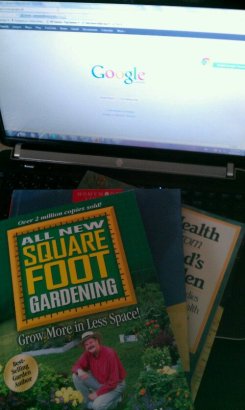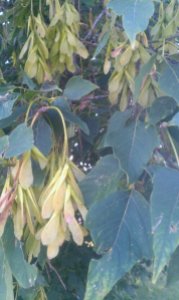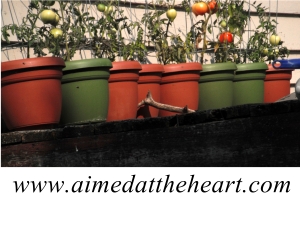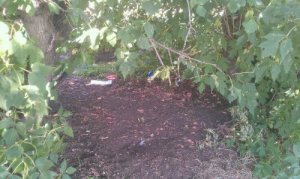


Turning All Those Stupid Little Crab Apples into Butter

I have a crab apple tree. It is nestled comfortable between my maple trees. For four summers I have watch those tart little apples drop to the ground and sit there, undisturbed, while they compost throughout the winter. I planned to let the same thing happen again this year because I didn’t think they had any purpose other than to feed the birds. Then I had this wonderfully terrible thought: why don’t I “Google” it?
Crab apples make very good crab apple butter. I was recently given a jar of apple butter by a friend and it tasted like apple pie on toast. I LOVE apple pie! (If you are local and want to give me one I won’t turn you down!)
Here is the story of my quest for apple butter:
1. Go to Google to find a recipe.
2. Google how to get the apples off the tree and discover that I’m supposed to shake them off. They make it sound so easy. It is, in fact, quite a workout. Put on a long sleeved shirt (the branches scratch something fierce!) or hire someone with strong, energetic arms (I told my husband that it would be a great family bonding activity). Plus get a couple of adorable little boogs with buckets to pick them up. Dump trucks work too. 
3. The recipe told me to cut off blossoms and stems: You could probably just take a shortcut and leave the blossoms. You’re going to strain them out anyway. And give yourself some time! Estimated time: 3.5 hours.
4. Cover with water and cook till really mushy: Make sure that the correct burner is on so you don’t accidentally burn your nice bamboo mixer. Estimated cooking time: (not including the burner mistake) 2 hours.
5. Strain: Wow There has got to be an easier way! The recipe called for a “coarse” sieve so, naturally, I grabbed my fine metal one. Decided it was taking too long so I upped the ante: my blue coarse pasta strainer. That one was not sturdy enough for me to mash through. Grabbed my big metal colander. Worked decently but took forever! The holes were in the wrong spot. So I downgraded again to my blue one. Nope, still not sturdy enough. Back to the fine mesh metal one. I should have just stuck with this one because it ended up being the simplest to use. Grabbed my spatula and started mashing. Then went to bed, woke up, did chores, and mashed some more.
Estimated time to strain all the apples: 4 hours
6. Spice, sugar and cook: I figured it was all downhill from here. All I had to do was add some spices and cook it, right? Well, I have a few tips:
- It splatters. A lot. I managed to get burned. Several times. (Then I got smart and started using an oven mitt while mixing it). I’m so glad that my aloe vera plant managed to recover from it’s near death experience after I first bought it. It’s coming in really handy.
- Also, the recipe told me it would need to simmer for 2 hours. That’s a little off. Mine simmered for a total of 24 hours. Note to self (and anyone else who makes it this far in their quest for apple butter): If it still looks like apple sauce, don’t try to can it! I was super excited after two hours to get out my jars and have my first try at canning. I had my pots all ready, tools within reach, filled my jars, and then had a thought: What is the difference between apple butter and apple sauce? So I Googled it. The difference is very small: To make apple butter you add spices and simmer longer. Much, much longer. I poured my apple sauce back into my pot.
- You get a much better texture if you blend it. I used my stick mixer but you can use whatever you have on hand.

7. Canning: The simplest way that I could find to tell if the apple sauce has turned into apple butter is to put a teaspoon on the counter and wait for 5 minutes. If there is no water pooling around it then it’s ready to can. Since I had never even seen someone else can anything I needed to give myself a quick tutorial. So, of course, I went to my trusty friend, Google. I was lucky enough to find out that somewhere along the way I managed to acquire some tools for canning (jar lifting tongs and a metal rack for the bottom of my pot). I still have no idea where they came from but I’m glad that I kept them!
8. Enjoy: I used 2 cup jars and have 7.5 of them. I’m not ready to look at them yet. Maybe when my burns heal and the rest of the crab apples fall of the tree I will be ready to move to this stage. I thought I might give the jars as gifts but, as much as I don’t even want to look at them right now, I’m going to be selfish. I worked hard for that butter and one day I’m going to enjoy it!
Make sure you don’t miss any posts by subscribing to my weekly blog newsletter!

Living Simply Shouldn’t Be Stressful

It has occured to me how complicated we can make our effort to living simply. We feel that we need to do it all and then some. We read blogs and books and feel like if we aren’t growing everything we eat and making everything we use, we must be doing something wrong. This revelation came to me when I was reading an article on how to simplify your DIY.
Or maybe I’m just talking about myself here. I know that I have a tendency to over complicate things. I have a wonderfully annoying habit of researching the pants off of anything and then trying to dive in head first. I really should remember what my goals are for changing our lifestyle.
I have a number of reasons: frugality, health, appreciating the simple things, teach my kids the importance of work and more. But, when I dream about my goals for my life, I don’t picture money in the bank, or being superfit/healthy. I picture being able to take the time to enjoy my family. Working alongside them without being tied down by the craziness of this world. Slowing down. Peace.
Now I need to ask myself, will what I’m doing lead me to that life? I’m pretty sure that, if I attempted to learn and do everything at once (garden, canning, herbalism, soap making, cheese making, weaving, knitting, sewing, building and wood working and the list goes on) that I would just burn out. We are not designed to do it all. And very few people are able to dive in head first without drowning. That doesn’t sound very peaceful to me.
So, instead of my grand plan for our garden this year, I managed to move one step further than last year. The only vegetables I planted were tomatoes and carrots. Oh, and onions because I saw an idea on pinterest and thought it would be a simple way to use up the space where I planted my chamomile (that didn’t come up). I planted in containers because I figured it made sense to have a portable garden due to our impending move. I watered with a bucket from my kitchen sink because I have no faucet on my house. And I watched and waited. I did very minimal weeding (one of my favorite parts of container gardening) and only a little bit of fertilizing.
My garden took about 10 minutes to care for every couple of days and I didn’t lose my mind. I learned a lot about growing tomatoes and carrots. I didn’t get a huge and bountiful crop this year but I did manage to learn enough to point me in the right direction for next year’s garden.
Next year my goal is small: plant enough of a garden so I don’t need to buy veggies through the growing season. If that goes well, the year after next I’ll plant enough so that we can store some for the winter.
But, for now, 10 minutes extra into my schedule is simple. Because simplifying should be simple to do.Another couple great posts that I have recently read that are great grounders when you’re feeling overwhelmed or like you’re not doing enough:
How Do you Know When You Are Natural Enough? (Cheeky Bums Blog)
dear sweet mom who feels like she is failing (Finding Joy)
Make sure you don’t miss any posts by subscribing to my weekly blog newsletter!
[mc4wp-form]

Manitoba Maples
 Have you ever heard of a Manitoba Maple? A lot of people look at it as a weed because it throws off seedlings like crazy. A wonderful thing about Manitoba maple trees is that they grow in Alberta. The best part: you can tap them!
Have you ever heard of a Manitoba Maple? A lot of people look at it as a weed because it throws off seedlings like crazy. A wonderful thing about Manitoba maple trees is that they grow in Alberta. The best part: you can tap them!
I would love to make enough syrup every year for my own family. I think it would be a fun experience for us, plus I have a feeling it would be absolutely delicious. However, I have done a bit of research and Manitoba maples take about 25-50 years before they are large enough to tap. Even when they are large enough to tap, you need to harvest 40 liters of sap to make 1 liter of syrup. They should be at least 8 inches in diameter and the average (which is usually larger that 8 inches diameter) will yeild about 56 liters. So that means one tree will yield just over 1 liter of syrup.

I have recently discovered I have about 4 of these trees growing in my front yard. This is my family’s 5th summer here and I have just discovered what kind of trees they are. I wish I had discovered this sooner. Perhaps in February or so. That would allow us time to prepare to tap them.
Now we are moving.
I have found some of those seedlings and I plan to take them. Did you know that fall is a good time of year to transplant trees? I do believe that will work. And then I’ll wait for 25 years until they grow big enough to tap. Do I need the syrup? Obviously not. It will be a labour or love. Because in addition to providing delicious syrup, Manitoba Maple trees are deliciously beautiful!











